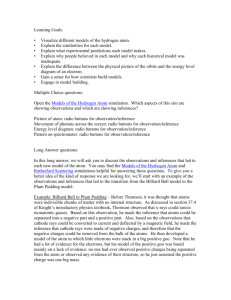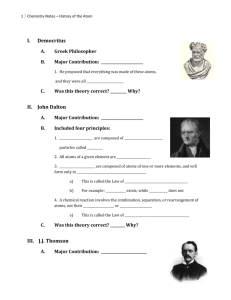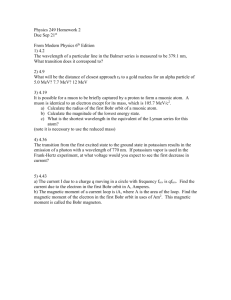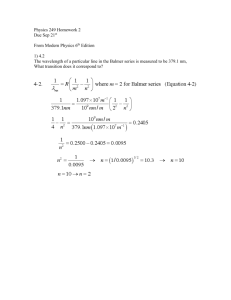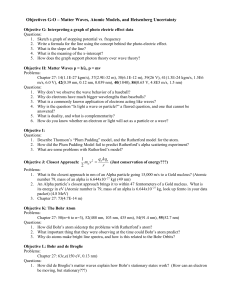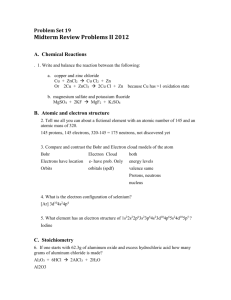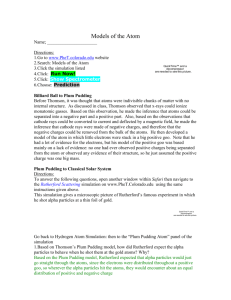phet activity
advertisement
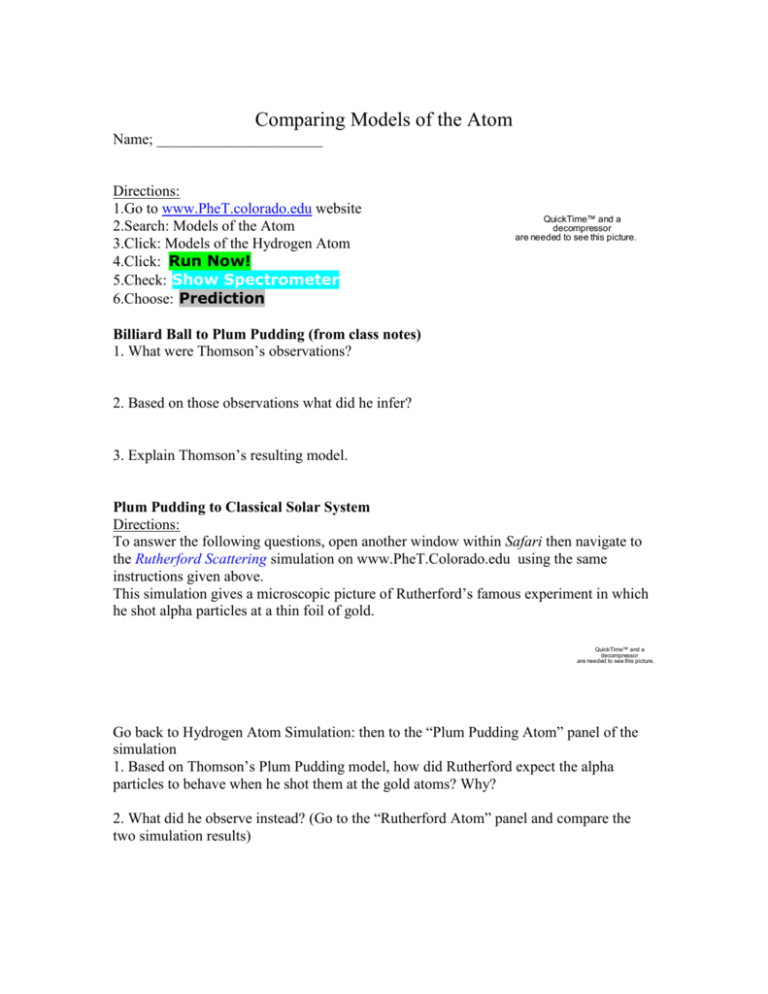
Comparing Models of the Atom Name; ______________________ Directions: 1.Go to www.PheT.colorado.edu website 2.Search: Models of the Atom 3.Click: Models of the Hydrogen Atom 4.Click: Run Now! 5.Check: Show Spectrometer 6.Choose: Prediction QuickTime™ and a decompressor are needed to see this picture. Billiard Ball to Plum Pudding (from class notes) 1. What were Thomson’s observations? 2. Based on those observations what did he infer? 3. Explain Thomson’s resulting model. Plum Pudding to Classical Solar System Directions: To answer the following questions, open another window within Safari then navigate to the Rutherford Scattering simulation on www.PheT.Colorado.edu using the same instructions given above. This simulation gives a microscopic picture of Rutherford’s famous experiment in which he shot alpha particles at a thin foil of gold. QuickTime™ and a decompressor are needed to see this picture. Go back to Hydrogen Atom Simulation: then to the “Plum Pudding Atom” panel of the simulation 1. Based on Thomson’s Plum Pudding model, how did Rutherford expect the alpha particles to behave when he shot them at the gold atoms? Why? 2. What did he observe instead? (Go to the “Rutherford Atom” panel and compare the two simulation results) 3. Based on his observations, what inference did Rutherford make about the distribution of positive charge in the atom? Classical Solar System to Bohr 1. Go back to the Models of the Hydrogen Atom simulation. What observation can you make about the light detected by the spectrometer in experiment mode that Rutherford’s solar system model is unable to explain? 2. Based on this observation, what inferences did Bohr make about the nature of atoms? 3. How was this inference able to explain the observation? 4. Explain the relationship between the behavior of the electron in the picture of the atom and the energy level diagram for the Bohr model. As n gets larger, do the orbits get closer together or farther apart? Why? 5. As n gets larger, do the energy levels get closer together or farther apart? Why? Bohr to deBroglie The deBroglie model is different from the previous models we have discussed in that it was based on a theoretical argument, rather than on experimental observations. (There is no experimental difference between the Bohr model and the deBroglie model!) 1. What was the problem with the Bohr model that deBroglie sought to address? 2. How did he address this problem? 3. Do you think his argument was convincing? 4. How did these observations support his model? 5. How is deBroglie’s view of the electron different from Bohr’s view? 6. What is the purpose of the three different views of the deBroglie electron in the Models of the Hydrogen Atom simulation? 7. Which view do you find most useful for helping you understand the nature of the electron in this model? Why? 8. Name at least three observations scientists made that were either inconsistent with, or inadequately described by, the Bohr and deBroglie models. Discuss how the models were inadequate or inconsistent for each of these observations. 9. Describe the Schrodinger model of the atom (you may want to use the sim) and discuss how this model addressed each of the inconsistencies you listed in question 6. 10. Explain the relationship between the behavior of the electron in the picture of the atom and the energy level diagram for the Schrodinger model. Compare and contrast this explanation with the explanation you gave for the Bohr model in question 3. Summary Compare all six models by performing the same test. Note any similarities or differences. Directions: Turn the simulation speed up to “fast” so that you can build up the spectrometer pattern more quickly. Then run the spectrometer for a minute for each model and take a snapshot with the camera button on the spectrometer. Compare the spectrometer readings for each model. Billiard Ball Plum Pudding Solar System Bohr DeBroglie Schrödinger **Note **Photons that come in and excite the electron at any given moment are random, so pay attention to the overall pattern, not to small fluctuations in the numbers emitted. Explain, based on the spectrometer readings, the differences between each of the models. Which prediction spectrometer reading is most similar to the spectrometer reading in Experiment mode? Why?
